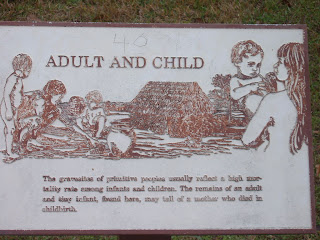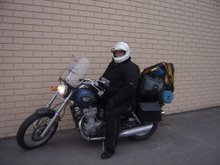It's raining once again. And it is absolutely pouring. It started around 9PM last night and it is certainly giving my tent a workout.
All that was left to decide was what to use to mop the water off the tent floor. You do remember the name of the tent don't you? Ozark Trail.
The first place we stop to check out has two parts,





 This sign says: Adult and Child The gravesites of primitive peoples usually reflect a high mortaility rate among infants and children. The remains of an adult and tiny infant found here, may tell of a mother who died in childbirth.
This sign says: Adult and Child The gravesites of primitive peoples usually reflect a high mortaility rate among infants and children. The remains of an adult and tiny infant found here, may tell of a mother who died in childbirth.


 The sign says: Sunken Trace Preserved here is a portion of the deeply eroded or "sunken" Old
The sign says: Sunken Trace Preserved here is a portion of the deeply eroded or "sunken" Old






Wow, this was just great for me. I can still feel people's souls.





The squares with the nuts are for the earthquake rods. When tightened they are supposed to hold the building together in an earthquake.
We go cruising through town looking for freebies when we come across this field that is filled with stuff hanging all over. Spanish moss?


We find the freebies and then head back to the campground. Happy trails, Marty
How dry am I? Well, I am dry, much dryer than I was last Tuesday. but then, I am prepared. You do know what prepared means don't you? A plethora of plastic bags on hand, in many different sizes. The laptop is in a garbage bag. The backpack is in a garbage bag. All clothes are in zip lock bags. (See how quickly I learn?) snicker.
I also have a poncho.
All that was left to decide was what to use to mop the water off the tent floor. You do remember the name of the tent don't you? Ozark Trail.
I get out of the tent and Wendy asks me if I want to go to town. YES. I grab a bite to eat, rearrange my backpack to include my laptop and cables, and try to hurry on over. (I wish that I hurried better as I still get wet.)
After we take off the rain starts to abate. (Maybe it is just in this campground that there's a problem?) grin
And since the rain has let up we stop at a couple of places to look around.
The first place we stop to check out has two parts,

1. Grindstone Ford and
2. Mangum Mound
(The sign says: Travelling the Natchez Trace takes you back in time. Two layers of history that shaped the Natchez Trace can be seen at Mangum Site, an ancient burial ground and a vestige of late prehistoric culture, and Grindstone Forge the threshold between civilization and wilderness on the old Natchez Trace.)
We chose to go towards Grindstone Forge first.
This sign says This ford marked the beginning of the wilderness of the Choctaw nation and teh end of the old Natchez District. Nearby fort Deposit was a supply depot for troops clearing the Trace in 1801 - 02, and troops were assembled here during the Burr conspiracy alledgedly to separate the Western States from the Union. The site takes its name from a nearby water mill.
The trail to your left takes you to the Old Trace and Grindstone Ford.


 The following sign says: Riverboatmen on foot or horseback crossed here, northbound, after floating cargoes down the Ohio and Mississippi, to New Orleans. Soldiers splashed across from the north to protect the Natchez District from British and Spanish threats. For post riders, Indians, Bandits and Preachers Bayou Pierre was the line between civilization and wilderness.
The following sign says: Riverboatmen on foot or horseback crossed here, northbound, after floating cargoes down the Ohio and Mississippi, to New Orleans. Soldiers splashed across from the north to protect the Natchez District from British and Spanish threats. For post riders, Indians, Bandits and Preachers Bayou Pierre was the line between civilization and wilderness.




 The following sign says: Riverboatmen on foot or horseback crossed here, northbound, after floating cargoes down the Ohio and Mississippi, to New Orleans. Soldiers splashed across from the north to protect the Natchez District from British and Spanish threats. For post riders, Indians, Bandits and Preachers Bayou Pierre was the line between civilization and wilderness.
The following sign says: Riverboatmen on foot or horseback crossed here, northbound, after floating cargoes down the Ohio and Mississippi, to New Orleans. Soldiers splashed across from the north to protect the Natchez District from British and Spanish threats. For post riders, Indians, Bandits and Preachers Bayou Pierre was the line between civilization and wilderness.

Here are Paul and Wendy walking down this section of the Old Trace.

This is the sign that is near Wendy. It reads: Daniel Burnetts Stand...stood near hear. Barnett was a speaker of the Territorial House of Representatives, a principal negotiator with the Chocktaw and a framer of the state constitution--but his stand was unpretentious. His guests supped on mush and milk in a room filled with their own gear and Barnett's supplies. From here you may follow their path to Grindstone Ford.

We didn't make it all the way to the Grindstone Ford itself because none of us wanted to wade through water that deep.


We decided to leave and go on to Mangum Mound. 

The sign says:Excavation of this site tells us much about the people of the late prehistoric periods. The Plaquemine culture included the ancestores of the modern tribes of Mississippi and Louisiana. It was a society with elaborate agriculturally oriented religious ceremonies. From the burials on this mound we have learned that htere was a high infant mortality and that upon the death of a chief, a brutal ritual was enacted in which his retainers were slain and buried with him.
There are four signs on top of Mangum Mound: 
This one talks about a type of burial called a "Bundle Burial". Death may have overtaken this man far from home. His companiions might then have put his body on a platform and goine on their way until decay reduced the body to a skeleton. The remains could then be bundled together for burial here among his own people. 

This one is titled prehistoric tragedy. It says: This group burial suggests a custom of the Natchez Indians, who continued many of the traits of these people. Early explorers found that when on Natchez parent died, the other sometimes took the lives of the rest of the family, apparently as a gesture of grief and respect.

And things didn't seem to be much better for servants. This sign states: "Servants in the Hereafter". Human sacrifice was a custom of the later Natchez. When a "nobleman" died, his slaves wwere often strangled and buried with him. The discovery of several adults' skeletons in a single grave indicates this may have happened here.
 This sign says: Adult and Child The gravesites of primitive peoples usually reflect a high mortaility rate among infants and children. The remains of an adult and tiny infant found here, may tell of a mother who died in childbirth.
This sign says: Adult and Child The gravesites of primitive peoples usually reflect a high mortaility rate among infants and children. The remains of an adult and tiny infant found here, may tell of a mother who died in childbirth. 

This is a view from the mound area.
And now we are off down the road. Wait, wait, there's another place to stop. "What does the "Sunken Trace" mean?"
 The sign says: Sunken Trace Preserved here is a portion of the deeply eroded or "sunken" Old
The sign says: Sunken Trace Preserved here is a portion of the deeply eroded or "sunken" Old Trace. Hardshiops of journeying on the Old Trace includeed heat, mosquitoes, poor food, hard beds (if any), disease, swollen rivers, and sucking swamps. Take 5 minutes to walk this sunken trail and let your imagination carry you back to the early 1800's when people walking 500 miles had to put up with these discomforst and where a broken leg or arm could spell death for the lone traveler. 

The pics don't do the sunken trace justice. It is just amazing. The feelings that are there, left behind, don't photograph.






Wow, this was just great for me. I can still feel people's souls.
But we have to make it to Port Gibson. We have things to do, places to go, people to see. lactose free milk to pick up;)
But on the way we find this church. ee-i-ee-i--oooooo.







We find the freebies and then head back to the campground. Happy trails, Marty


No comments:
Post a Comment